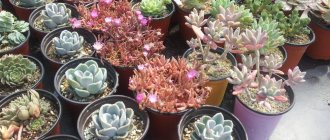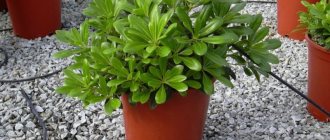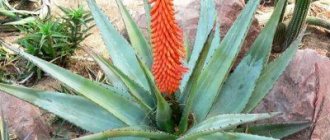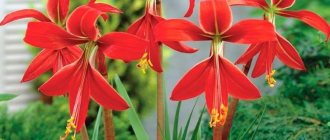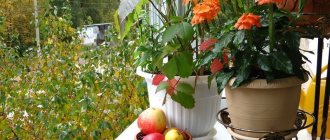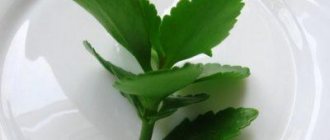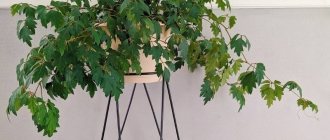Aeonium
This plant has very beautiful and spectacular rosettes. The stems may become woody over time. Some species grow up to 1 meter in height.
Flowers appear on the plant from the end of winter, and flowering continues until the end of spring. The flowers are white or yellow. They look very beautiful. These can be tall multi-flowered cones or scattered small bushes consisting of tiny flowers.
After flowering the plant dies. However, it reproduces offspring that remain after the parent. The plant looks very beautiful, so it can easily become a spectacular decoration for any garden plot or flower pot.
Aloe
It is an evergreen medicinal plant that grows throughout the year. In summer it can bloom with yellow flowers.
Hormonal balance is fine: scientists explained the healing power of hugs
We clean wooden floors and furniture from oil stains: use home remedies
The young wife of Valery Syutkin: what does she do
Aloe does best in full sun, but can easily tolerate some shade. Aloe prefers sandy and well-drained soil. As with most succulents, watering is needed when the soil gets dry, but aloe can tolerate drought. Watering is especially important during the growth and flowering period.
Rosettes with green and variegated leaves look very beautiful in pots. However, it is worth remembering that when growing aloe as a houseplant, it very rarely blooms.
How to plant and propagate?
Before replanting any type of purchased succulent into a new pot, you need to prepare the soil for it. You will find numerous ready-made mixtures on sale, but not all manufacturers approach their preparation responsibly and maintain the proportions.
Therefore, it is safer to prepare the soil at home. The recipes here are similar to the variations of borscht from different housewives, but the main thing to learn is that the soil should be “poor” and loose.
The easiest way is to mix 1 part turf soil, 1 part peat substrate, 1 part baking powder - brick or stone chips, river sand, purchased perlite, vermiculite, expanded clay.
Plants are replanted as needed; it is better to plan replanting in the spring (from March-April) or summer.
In the photo there is a variant of propagation by leaves
The second point is reproduction. The process is different for each type, let’s look at the main variations:
- Leaves. Most succulents are distinguished by their ability to grow from a leaf - the process is not fast, but a large number of plants can be grown at once.
- By cuttings. The method is only possible for stem varieties; it is preferred as a way to speed up the growth of a new flower. Cut a twig with several leaves, stick it into the ground or vermiculite, water it and leave it: a root will soon form and the active growth phase will begin.
- Children. Some varieties form babies on themselves: for example, Kalanchoe. If you use these crumbs and plant them in the ground, they will soon become independent representatives of the species.
- Seeds. The slowest method, but facilitates transportation from other countries and continents.
Important! Containers for succulents must have drainage holes or a thick drainage layer of large expanded clay so that water does not stagnate in the roots.
Crassula
This is a very beautiful indoor plant that has long been grown on windowsills. Crassula tolerates almost any soil as long as it is well-drained. This plant prefers bright light, but tolerates shade well.
If Crassula is not refined and allowed to grow as it pleases, then over time it turns into a huge shrub that can reach 1 meter in height, with branched trunks and fleshy leaves.
The prototype of the European constitution appeared in Rome: where did the common people go?
Prayer that is read at home on Parents' Saturday if they cannot go to church
40 years of the Leningrad rock club: memories of Garkusha, Kinchev and others
To successfully grow this plant, no fertilizer is required. When grown indoors, Crassula blooms very rarely, but outdoors you can expect tiny white or pink flowers to appear very quickly, blooming from late autumn to early winter.
Echeveria
There are many different varieties of Echeveria. All known varieties of this plant are distinguished by their classic rosette shape and variety of leaves. Evergreen leaves come in a variety of shades, and flowers of various colors are located on thin stems. Echeveria is very hardy.
This plant prefers full sun or partial shade and sandy, well-drained soil. There is no need to apply fertilizer, but a slow-release nitrogen fertilizer can be used. When watering, you want the moisture to fall on the soil and not on the leaves. This will help protect the wax coating and prevent rotting.
Depending on the variety, this may be a low-growing groundcover variety or saucer-sized rosettes on the stem. You can trim the plants and root the cuttings.
Succulents: sun and shade
In general, succulents need half a full day of sun, ideally in the morning, and can spend the rest of the day in partial shade. Keep in mind that the intensity and duration of sunlight varies depending on the latitude and altitude of the sun throughout the seasons, and on different directions and locations in your garden or window sills. In addition, the same succulents that like to bask in the sun all day in temperate climates, in the tropics, subtropics and at the equator, will get by with only 30 minutes of direct sunlight. Plants that want more sun won't actually bloom without it - cacti and yuccas and aloes from South Africa. They need adequate light for balanced growth (so they don't get stretched out), and any succulent plant grown in low light conditions or in a greenhouse should be hardened off gradually by the sun's rays to tolerate high sun exposure. “Tan” appears as permanent beige or brown spots, and if it is extensive, it can lead to the death of succulents. The few that are sun intolerant, such as Sansevieria and Haworthia, make great shaded areas in the home. Variegated (striped) succulents, which have less protective pigment, want less sun than their solid-colored cousins.
Graptopetalum
In bright light, the leaves on the plant become pale pink, but may partially acquire a gray-green tint. Graptopetalum grows well in sandy, well-drained soil with little moisture. However, it loves watering, especially during growth and flowering.
Neon French: a spring manicure that can be done without going to the salon
Red and white sponge cake with coconut cream: a holiday dessert recipe
Better than other sisters: by highlighting a favorite, a father fosters success in children
When grown outdoors in spring, the slender stems produce small white star-shaped flowers with red accents. Grows well on rocky slopes or in hanging pots.
In what conditions should it be kept?
Lighting
Since in the wild they are residents of hot, arid areas, in order to work with succulents at home you should provide them with constant light. One option is to place it on a windowsill, but it is better to protect it from direct sunlight - the tips will begin to “burn” and change color.
If it is not possible to grow in the sun, but there are quite a lot of succulents, it is recommended to supplement the lighting with a special phyto-lamp.
Air
It is better to grow thrifty plants in conditions of low humidity: succulents will more easily tolerate dry hot air from a radiator than humid air in the bathroom.
Temperature
In the usual climate, many representatives of the species have developed the ability for CAM photosynthesis: that is, the main metabolism in their cells occurs during the cool night time. Therefore, at home, it is also advisable to ensure a large temperature difference - hot during the day, cold at night (but you should not freeze them).
In the summer, calmly take the pots outside or onto the balcony - the flowers grow well in the fresh air. In open areas you don’t even need to water them; summer rain is enough.
Important! You shouldn’t keep succulents outside in wet, cold autumn; they don’t tolerate waterlogging well.
Haworthia
This plant resembles aloe. Warty white stripes on the dark evergreen leaves give Haworthia a variegated appearance.
There are many species in this family. Some have leaves that are quite dense and shiny, so they can burst. Haworthia grows well in full sun and sandy, well-drained soil. It is worth watering with a slow-release fertilizer during the growing and flowering period.
This plant can be grown outdoors in a container that can be easily moved indoors for the winter. In the spring, you need to check indoor plants and, if necessary, replant them so that there is enough space for the growth and reproduction of rosettes.
How to care?
Even despite the reserves of water in the cells and the ability to save it, the group still needs regular watering. The best way to observe the soil is to hold a wooden stick near the pot and pierce a layer of 1.5-2 cm from the surface with it. If this entire space is dry, you can water it. Wet - postpone moisturizing until later.
Important! There is an unspoken rule: it is better to skip watering than to overwater.
It is also advisable to avoid severe drying out: if the leaves have withered and become lethargic, it means that too much time has passed between adding water.
Fertilizers will help provide comfortable conditions for plants: fertilizing is done only during the growth period (March-October), using non-nitrogen compounds. The concentration should be low (using universal ones, divide by 2); watering with vitamins should be no more than once a month.
Lithops
This is one of the most unusual succulents, popularly called “living stones”. In the wild, Lithops grows mostly underground, exposing only the tips of its leaves to soak up all the nutrients.
The lush white or yellow daisy-like flowers that emerge from cracks in the center of the plant look very beautiful. Lithops can be grown in shallow pots or in the garden where it grows densely, creating a beautiful textured earthy mosaic of green, brown or blue.
Lenten dessert without flour: semolina pie turns out so good you'll lick your fingers
What natural sounds should you listen to to lift your mood and relieve stress?
How to make a bright vertical flower bed for a summer cottage: master class
This plant loves gravelly, well-drained soil and bright light. Water requirements are low. During winter dormancy, they require almost no moisture. However, when new leaves or flowers appear, you need to water every time the soil is completely dry.
Purslane
This is an annual that grows well even if this plant is neglected. It requires good lighting and sufficient watering, but can withstand short droughts. This annual does not tolerate cold, so in early autumn you need to move the plants indoors.
Sandy, well-drained soil is ideal. The plant is distinguished by the fact that it has many spectacular and bright flowers with single or double rows of petals. The narrow, fleshy leaves resemble in appearance pine needles growing on hanging stems. Suitable for growing in rock gardens and hanging pots.

